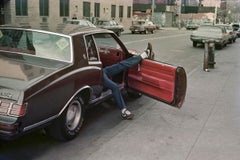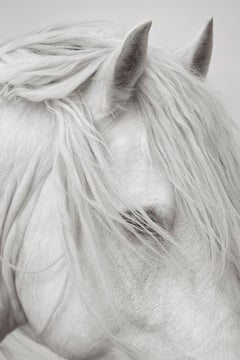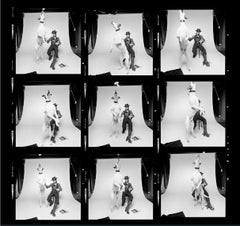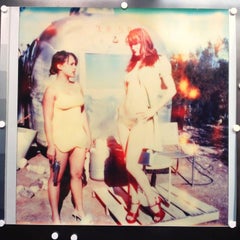Portrait Photography
20th Century American Realist Portrait Photography
Archival Pigment, Photographic Paper, Color, Pigment
2010s Contemporary Portrait Photography
Archival Pigment
Early 2000s Contemporary Portrait Photography
Archival Paper, Photographic Paper, C Print, Color, Polaroid
Late 20th Century Photorealist Portrait Photography
C Print
Early 2000s Contemporary Portrait Photography
Archival Paper, Photographic Paper, C Print, Color, Polaroid
Early 2000s Contemporary Portrait Photography
Archival Paper, Photographic Paper, C Print, Color, Polaroid
2010s Contemporary Portrait Photography
Photographic Paper, C Print
1980s Contemporary Portrait Photography
Archival Pigment
1970s Modern Portrait Photography
Lambda
2010s Contemporary Portrait Photography
Archival Pigment
1990s Contemporary Portrait Photography
Archival Paper, Photographic Paper, C Print, Color, Polaroid
21st Century and Contemporary Contemporary Portrait Photography
Archival Pigment
2010s Contemporary Portrait Photography
C Print
2010s Contemporary Portrait Photography
Archival Paper, Photographic Paper, C Print, Color, Polaroid
21st Century and Contemporary Photorealist Portrait Photography
Giclée
1950s Modern Portrait Photography
Black and White, Silver Gelatin
Mid-20th Century Modern Portrait Photography
Platinum
1950s Realist Portrait Photography
Lambda
2010s Contemporary Portrait Photography
Archival Pigment
2010s Contemporary Portrait Photography
Archival Pigment
Early 2000s Contemporary Portrait Photography
Parchment Paper, Photographic Paper, C Print, Color, Polaroid
1920s Modern Portrait Photography
Black and White, Silver Gelatin
21st Century and Contemporary Realist Portrait Photography
Canvas, Oil
Early 2000s Contemporary Portrait Photography
Archival Paper, Photographic Paper, C Print, Color, Polaroid
Early 2000s Contemporary Portrait Photography
Photographic Paper, Black and White, Inkjet, Archival Pigment
2010s Contemporary Portrait Photography
C Print
2010s Contemporary Portrait Photography
Mixed Media, Oil, Acrylic, Archival Pigment
Early 20th Century Modern Portrait Photography
Photographic Paper
20th Century Contemporary Portrait Photography
Archival Paper, Archival Pigment
2010s Contemporary Portrait Photography
C Print
1970s Modern Portrait Photography
Silver Gelatin
2010s Contemporary Portrait Photography
Archival Pigment
2010s Portrait Photography
Photographic Paper
2010s Contemporary Portrait Photography
Archival Paper, Photographic Paper, C Print, Color, Polaroid
2010s Contemporary Portrait Photography
Archival Pigment
1990s Contemporary Portrait Photography
Photographic Paper
2010s Contemporary Portrait Photography
Archival Pigment
1950s Modern Portrait Photography
Archival Pigment
20th Century Portrait Photography
Silver Gelatin
Late 20th Century Photorealist Portrait Photography
Silver Gelatin
1960s Modern Portrait Photography
Silver Gelatin
Early 2000s Contemporary Portrait Photography
Archival Paper, Photographic Paper, C Print, Color, Polaroid
Early 2000s Contemporary Portrait Photography
C Print
Early 2000s Contemporary Portrait Photography
Archival Paper, Photographic Paper, C Print, Color, Polaroid
1970s Realist Portrait Photography
Photographic Paper
2010s Contemporary Portrait Photography
Archival Pigment
1950s Modern Portrait Photography
Black and White, Silver Gelatin
1990s Modern Portrait Photography
Black and White
Early 2000s Contemporary Portrait Photography
Archival Pigment
1990s Contemporary Portrait Photography
Photographic Paper, C Print, Polaroid
20th Century Portrait Photography
Silver Gelatin
2010s Contemporary Portrait Photography
Archival Paper, Photographic Paper, C Print, Color, Polaroid
2010s Pop Art Portrait Photography
Archival Pigment
1960s Contemporary Portrait Photography
Photographic Paper, Photographic Film
Early 2000s Contemporary Portrait Photography
Archival Paper, Photographic Paper, C Print, Color, Polaroid
2010s Contemporary Portrait Photography
Archival Pigment
1970s Pop Art Portrait Photography
Silver Gelatin
21st Century and Contemporary Contemporary Portrait Photography
Photographic Paper, C Print, Color, Silver Gelatin
1990s Contemporary Portrait Photography
Archival Ink, Archival Paper, Rag Paper, Digital, Archival Pigment, Digi...
Late 20th Century Photorealist Portrait Photography
C Print
Portrait Photography for Sale on 1stDibs
Portrait photography can be a powerful part of your wall decor. Find a provocative and compelling portrait that speaks to you and you might find that the photograph will speak to your guests too.
Prior to the development of photography, which eventually replaced portrait paintings as a quicker and more efficient way of capturing a person’s essence, the subject of a portrait had to sit for hours until the painter had finished. In 1839, chemist and Philadelphia-based photographer Robert Cornelius didn’t have to wait very long for his portrait. In a matter of minutes, he captured what many believe to be the first portrait photograph. This shot was also the first self-portrait (or what we now call a “selfie”), and fine photography quickly became an art form.
Landscape photography, nude photography and portrait photography are very popular in today's modern interiors. A portrait can reveal a lot about the person in it. It can also add a narrative touch to your decor. You’ll often find that photographs of loved ones work well as decorative touches. A portrait of a family member or dear friend can help turn a house into a home, warming any space by evoking fond memories.
While family portraits can stir emotion, portraits of celebrities and important historical figures can also add a rich dynamic to your space. Portraits of famous musicians or intriguing actors hung in your dining room or home bar shot by Gered Mankowitz or Annie Leibovitz might inspire deep conversation over meals or drinks. Douglas Kirkland is also famous for his celebrity portraits. His photojournalism made him much sought after by Hollywood studios to document the filming of movies. In Kirkland’s powerful depiction of Hollywood stars, he excellently captures the glamour of their lives.
Other artists like Elliott Erwitt stand out by turning portraiture into a playful art form. Before graduating from high school in Hollywood, Erwitt had already begun to teach himself to take pictures, inspired by the work of Henri Cartier-Bresson. In image after image, Erwitt captured what photographers call “the moment” with rapier wit and penetrating humanity.
Portrait photography can be incredibly expressive, setting the tone and mood for a room. And there are different ways of incorporating portrait photography into your interior decor. If you’re thinking about adding color photography to a bedroom or living room, the colors of the portraits can become part of the room’s palette, while portraits shot in black and white won’t disrupt an existing color scheme.
On 1stDibs, find a vast selection of portrait photography from different eras, including 1950s portraits, 1960s portrait photography and more.
Read More
This Week-Old Calf Named Bug Is One of Randal Ford’s Most Adorable Models
In a recent collection of animal portraits, he brings fashion photography to the farm.
11 of Annie Leibovitz’s Most Talked-About Photographs
See why the famed photographer's celebrity portraits have graced magazine covers and become headline grabbers in their own right for five decades and counting.
Queen Elizabeth’s Life in Photos
She was one of the most photographed women in history, but the world’s longest-reigning queen remained something of a mystery throughout her decades on the throne.
Photographer to Know: William Klein
The noted lensman brought a bold sense of irony to fashion photography in the 1950s and '60s, transforming the industry. But his work in street photography, documentary filmmaking and abstract art is just as striking.
Chris Levine’s Portrait of a Shut-Eyed Queen Elizabeth Sparkles with Crystals
Celebrate the queen's Platinum Jubilee with a glittering, Pop-art version of the most famous and thought-provoking photo of Her Royal Majesty.
In Milan, La DoubleJ Celebrates Women of Design through Portraiture
During Salone del Mobile, Robyn Lea photographed some of the most powerful creative forces in the European design industry, decked out in J.J. Martin’s maximal fashion line.
Lori Grinker’s Artful Photographs of a Young Mike Tyson Are a Knockout!
The New York photographer tells us how an encounter with the then-13-year-old boxer led to a decade-long project that saw them both go pro.
John Dolan’s Photographs Capture the Art and Soul of a Wedding Day
In a new book compiling 30 years' worth of images, the photographer reveals that it's the in-between moments that make a wedding special.





